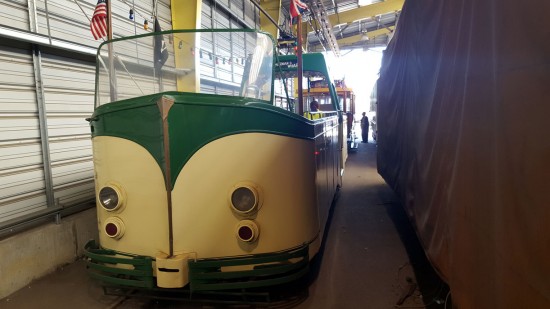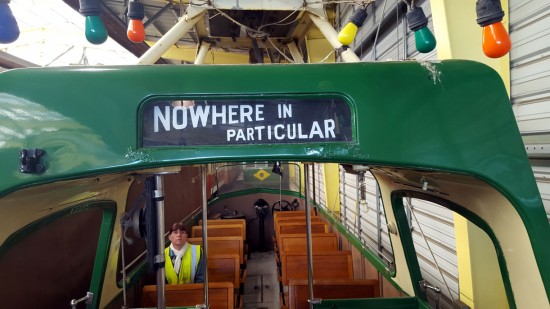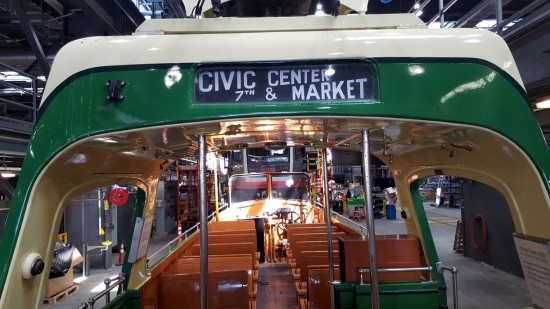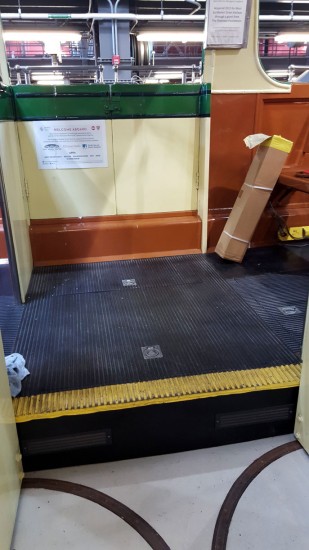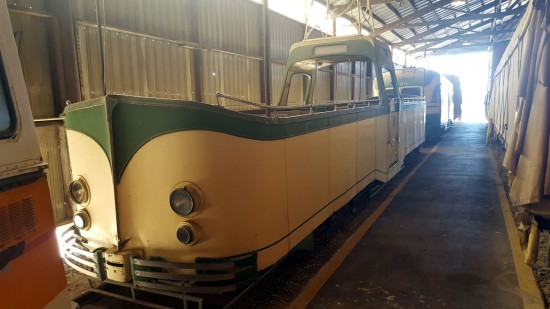Completing our look at the Blackpool Boat Cars which have found a new home in the USA today Blackpool destination blind guru Peter Watts reports on a recent visit to California where he was again using his skills for new sets of blinds…
At the beginning of October I had the opportunity to visit San Francisco for both business and pleasure. Obviously this was the ideal time to see old friends as the San Francisco area is home to three of Blackpool’s Boat trams. Here is a good time to mention that one of the business reasons was actually related to the trams, but more of that later!
As a brief résumé of which trams are where in California, 228 (603) and 233 (605) are with SFMTA (San Francisco Municipal Transit Authority, also known as MUNI) and 226 (601) is at the Western Railway Museum at Rio Vista. I refer to the Boats by their original 200 series fleet numbers, as this is how they are numbered today.
My visit started with the 228 and 233 at MUNI. For those who are not familiar with the operation in San Francisco, MUNI operates heritage streetcars on lines E and F. To put things in perspective, the F line carries around 23,000 people per day! The F line uses single ended cars as each terminus is via loops. The E line requires double ended cars as at one terminus there is no turning loop.
In 2016, MUNI has been suffering from a staff shortage on the heritage streetcars and the priority is on training the PCC car drivers. The PCC cars have a higher capacity and can be operated by one person. There is a mixture of single and double ended PCC cars. The Boat cars have a smaller capacity, and need to be operated by a 2 man crew, and in addition, the drivers have to have additional training after being passed out on PCC cars. This is the main reason that the Boat cars have not seen much usage this year, but this is set to change in 2017. Both Boats were out of service, but I had the opportunity to see both in their respective depots. 228 was in the Cameron Beach depot, whereas 233 was located in the MME facility (MUNI Metro East). This was interesting to see a 1934 Boat tram in a modern high tech workshop surrounded by modern LRT trams, but with the odd PCC dotted around. The MME facility is around 4 times bigger than Starr Gate.
The reason for my visit was that a complete set of new blinds for both 228 and 233 had been ordered by the Market Street Railway association. This is a voluntary group who supports the commercial heritage operation of MUNI, and who were responsible for sourcing the Boat trams. The new blinds have a mixture of Blackpool destinations, but also the current San Francisco destinations in the traditional diagonal font from Blackpool! One of the favourite destinations from San Francisco has thus been replicated, this being “NOWHERE IN PARTICULAR”. This destination has been used for many years in San Francisco for private hires.
Although we all know that the Boat trams are double ended, both 228 and 233 have had some modifications which render them as single ended cars for passenger use. They can still be driven from each end as the controllers have not been modified. However, the Californian code for public transit access for mobility impaired persons means that all trams, historic or modern, need to be able to fulfil their role carrying a wheelchair. The Californian code specifies a clear 36” space available for such use. San Francisco has built concrete ramps at many of its lower level stops (some stops have high level platforms). The Boats have been modified by building up the floor in the door area and removing one interior bulkhead partition. This means one door has been condemned, thus making the trams single ended for passenger use. This gives a good clear and flat area for wheelchairs.
Following on from this visit, the next trip was to the Western Railway Museum at Rio Vista. This is located around 60 miles from San Francisco. The museum caters for both trams and regional train preservation, and the site is very worthwhile to visit, including a significant track on which some of the trains are run. 226 came to the Museum quite early, in the late 1970’s being the first Boat tram to cross the Atlantic. Although it is currently out of service with a defective motor, discussions with the team out there confirm that it is in the queue for repair. A new depot will be constructed in 2017 for the tram collection, last year a similar climate controlled building was constructed for some of the regional train collection. The quality of restoration of the items of rolling stock here is to a very high standard.
To summarise, although several British tram enthusiasts are not too keen on 4 Boats being in the USA, I can confirm that all the threeCalifornian Boats have a secure and loving home. Once the issues with crews have been sorted out at MUNI, the Boats will see more action. Similarly once 226 has been repaired, it too will resume its role as a much liked tram to drive and ride on.
Peter Watts has now been appointed as the official liaison between Blackpool Heritage Tram Tours and the organisations which house Blackpool trams in the USA. This is to give a strong and official link between BHTT and other American operators/guardians of the trams.

